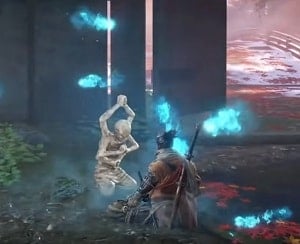This Sculptors Idol Is Unavailable Until It Is Communed With Again
Sculptor'due south Idol | |||
|---|---|---|---|
 | |||
|
Sculptor'due south Idols(鬼仏,Demonic Buddha) are the Checkpoints of Sekiro: Shadows Dice Twice. Much like Bonfires worked in Nighttime Souls and Lamps in Bloodborne, idols are found and unlocked throughout the globe. Resting at a Sculptors'southward Idol volition replenish the player'south White Spirit Emblem inventory upward to their Spirit Keepsake Cap (fifteen, at the start of the game) if they take whatever in storage.
Sculptor'south Idols in Sekiro: Shadows Die Twice
"Sculptor'southward Idols serve as a checkpoint and tin can be found throughout Ashina. Resting at a Sculptor's Idol will completely replenish vitality and restore one use of Resurrection. Additionally, Quick Items and Spirit Emblems in your storage volition be added to your current inventory.
With some exceptions, resting will also revive defeated enemies."
Idol Usage
- District with a sculptor's idol to Rest. The last Sculptor's Idol you rested at acts as a checkpoint.
- Sit at the idol to activate information technology and restore your wellness.
- As you are restored, any Spirit Emblems you have in storage will be returned to your inventory, up to your Spirit Emblem Cap.
- Travel: Warp to other Sculptor's Idols.
- Learn Skills: Use Skill points to unlock Skills and Skill Trees.
- Raise Physical Attributes: Upgrade your Vitality and Posture Gauges with Prayer Chaplet
- Enhance Assail Ability with Memory.
- Enhance Assail Power with skill points. (subsequently acquiring all pieces of the Dancing Dragon Mask, can be carried over to NG+ and beyond)
- Cure Dragonrot for all NPCs(require completing Emma's quest line, accept to redo for every NG+ cycle)
Locations of the Idols
Ashina Outskirts
- Dilapidated Temple
- Ashina Outskirts
- Outskirts Wall - Gate Path
- Outskirts Wall - Stairway
- Underbridge Valley
- Ashina Castle Fortress
- Ashina Castle Gate
- Flames of Hatred
Hirata Estate
- Dragonspring - Hirata Estate
- Estate Path
- Bamboo Thicket Slope
- Hirata Estate - Principal Hall
- Hirata Audience Chamber
- Hirata Estate - Hidden Temple
Ashina Castle
- Ashina Castle
- Upper Tower - Antechamber
- Upper Tower - Ashina Dojo
- Castle Tower Lookout
- Upper Tower - Kuro'due south Room
- One-time Grave
- Great Serpent Shrine
- Abandoned Dungeon Archway
- Ashina Reservoir
- Nigh Undercover Passage
Senpou Temple, Mt. Kongo
- Senpou Temple, Mt. Kongo
- Shugendo
- Temple Grounds
- Primary Hall
- Inner Sanctum
- Sunken Valley Cavern
- Bell Demon's Temple
Sunken Valley
- Under-Shrine Valley
- Sunken Valley
- Gun Fort
- Riven Cave
- Bodhisattva Valley
- Guardian Ape's Watering Hole
Ashina Depths
- Ashina Depths
- Poison Puddle
- Guardian Ape's Couch
- Hidden Forest
- Mibu Village
- Water Mill
- Wedding ceremony Cave Door
Fountainhead Palace
- Fountainhead Palace
- Vermilion Span
- Mibu Manor
- Flower Viewing Phase
- Bang-up Sakura
- Palace Grounds
- Feeding Grounds
- Virtually Pot Noble
- Sanctuary
Trivia
- The Sculptor'due south Idols were all carved and by The Sculptor (his name in Japanese, Busshi, literally means "Sculptor of Buddhas"). In his workshop at the Dilapidated Temple, you tin can see dozens of malformed, unfinished, or discarded Sculptor's Idols.
- In Japanese, the Sculptor's Idols are labeled 鬼仏,meaning "Demonic Buddha". Talking to The Sculptor reveals that he finds himself only able to carve "Buddhas that are an incarnation of wrath." Notation that "the Buddha" in this sense does not necessarily refer to Gautama, the founder of Buddhism (he himself is rarely depicted with more than two artillery) simply includes other figures in the Buddhist mythology.
- A common theme for Buddhistic statues is Ashura (originated from Asura in Hinduism and Ahura in Zoroastrianism), often shortened to Shura. In the context of the Buddhist mythology, the Ashura are demonic gods which have six arms and were initially wrathful and violent against Gautama the Buddha. They were later persuaded past Gautama and became one of the Eight Deities to protect the faith of Buddhism. Ashura's wrathful faces stand for their constant battles against the enemies of the Buddha, so they are technically benevolent gods subsequently the meeting with Gautama.
- Nevertheless, in the daily linguistic communication, the term Ashura (especially its shortened form Shura) oftentimes indicates burning malevolence and simple violence (as in Sekiro). Every Sculptor'south Idol has six arms, indicating that they are likely depictions not of the Buddha but of a Shura, foreshadowing events later in the game.
- Wooden-Buddha-idols-everywhere is probable based on the action by Enku, a sculptor-monk in the 17th century. Enku's idols are poor in aesthetic quality simply nevertheless his idols are highly revered because during his lifetime pilgrimage, he carved out more than 120,000 idols so that even impoverished people can go Buddha idols. On the other hand, in stark contrast to the Sculptor's work in Sekiro, almost all idols carved by Enku are smiling.
manzojohispent1945.blogspot.com
Source: https://sekiroshadowsdietwice.wiki.fextralife.com/Sculptor%27s+Idol
0 Response to "This Sculptors Idol Is Unavailable Until It Is Communed With Again"
Post a Comment